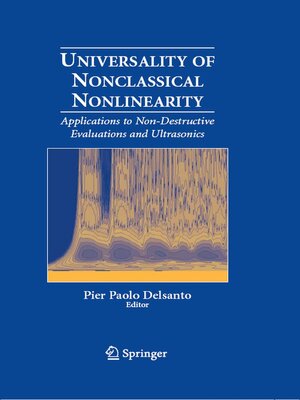Universality of Nonclassical Nonlinearity
ebook ∣ Applications to Non-Destructive Evaluations and Ultrasonics
By Pier Paolo Delsanto

Sign up to save your library
With an OverDrive account, you can save your favorite libraries for at-a-glance information about availability. Find out more about OverDrive accounts.
Find this title in Libby, the library reading app by OverDrive.



Search for a digital library with this title
Title found at these libraries:
| Library Name | Distance |
|---|---|
| Loading... |
VarietyisperhapsthemostamazingattributeofNature,withanalmostendlessarrayof different molecules and aggregates and tens of millions of distinct forms of life. Yet, in spite of this bewildering diversity, there are some common patterns, henceforth called "phenomenological universalities," that are found over and over again in completely different contexts. A quest for universalities is not only interesting per se, but can also yield practical applications. If several elds share a common mathematical or conceptual background, a cross-fertilization among them may lead to quick progress, even if ultimately the speci c details of any individual application must be considered independently. We all know that we live in a nonlinear world, although scientists have often tried to linearize it, sometimes as a rst step towards understanding its complexity, often because, before the advent of ubiquitous high computational power, a linear appro- mation was the only viable alternative. In this book we use the term "nonclassical n- linearity" with reference to a particularly intriguing kind of phenomenology, which has been extensively investigated in the last decade in the elds of elasticity and g- materials and whose universality has been conjectured. Its signatures are hystereticity, discrete memory, and other effects which, in the case of continuum mechanics, have been called "fast" and "slow" dynamics.







